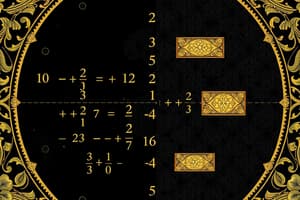Podcast
Questions and Answers
Which symbols are used in multiplication?
Which symbols are used in multiplication?
- 5(3) (correct)
- · (dot) (correct)
- ÷ (division)
- × (times) (correct)
Which of the following symbols are used in division?
Which of the following symbols are used in division?
- ÷ (division) (correct)
- : (colon)
- − (fraction bar) (correct)
- / (slash) (correct)
Flashcards are hidden until you start studying
Study Notes
Symbol Recognition
-
Multiplication Symbols:
- × (times): Most commonly used symbol for multiplication.
- · (dot): Used in higher mathematics and programming; less common in elementary education.
- *** (asterisk)**: Used primarily in computing and programming languages.
- ( ): Parentheses can indicate multiplication when placing numbers adjacent (e.g., (2)(3) = 6).
-
Division Symbols:
- ÷ (division): Traditional symbol for division; widely recognized in basic arithmetic.
- / (slash): Commonly used in programming and higher mathematics (e.g., 6/2 = 3).
- − (overbar): Used in fractional notation (e.g., 1/2 can be expressed as 1 − 2).
- : (colon): Sometimes used in ratios or proportions, but less common.
-
Contextual Usage:
- Multiplication: Indicates repeated addition; essential in arithmetic operations.
- Division: Represents the process of determining how many times one number is contained within another.
-
Associative and Commutative Properties:
- Multiplication:
- Commutative: a × b = b × a
- Associative: (a × b) × c = a × (b × c)
- Division:
- Not commutative: a ÷ b ≠ b ÷ a
- Not associative: (a ÷ b) ÷ c ≠ a ÷ (b ÷ c)
- Multiplication:
-
Importance of Symbols:
- Facilitate clear communication of mathematical ideas.
- Essential for problem-solving and expressing mathematical relationships.
Multiplication Symbols
- × (times): Most commonly recognized symbol for multiplication in basic arithmetic.
- · (dot): Utilized in advanced mathematics and programming to represent multiplication; not typically used in elementary education.
- *(asterisk): Primarily found in computing and programming contexts to denote multiplication.
- ( ): Parentheses signify multiplication when numbers are placed adjacent, e.g., (2)(3) equals 6.
Division Symbols
- ÷ (division): Traditional and widely recognized symbol for division in basic mathematics.
- / (slash): Frequently utilized in higher mathematics and programming, e.g., 6/2 equals 3.
- − (overbar): Appears in fractional notation; for example, 1/2 can be denoted as 1 − 2.
- : (colon): Occasionally used in ratios or proportions but is less common compared to other symbols.
Contextual Usage
- Multiplication: Represents repeated addition, which is fundamental in arithmetic operations.
- Division: Involves determining the number of times one quantity is contained within another.
Associative and Commutative Properties
- Multiplication:
- Commutative Property: a × b equals b × a.
- Associative Property: (a × b) × c equals a × (b × c).
- Division:
- Non-Commutative: a ÷ b does not equal b ÷ a.
- Non-Associative: (a ÷ b) ÷ c does not equal a ÷ (b ÷ c).
Importance of Symbols
- Mathematical symbols enhance clear communication of complex ideas.
- They are essential tools for problem-solving and articulating mathematical relationships effectively.
Studying That Suits You
Use AI to generate personalized quizzes and flashcards to suit your learning preferences.




